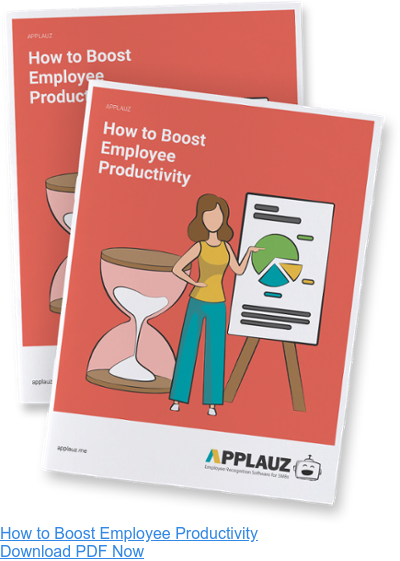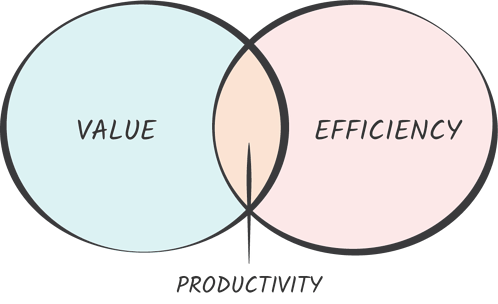Think about the last time you proudly said to yourself or your colleagues, “I was really productive today!”
What exactly did you mean by that? Most people assume that you crossed many items off your to-do list. In short, it’s all about the volume of things you accomplished.
This is the definition of productivity in the traditional sense: How much of X did you achieve in time frame Y.
Is the traditional Definition of productivity enough?
Although this straightforward definition of productivity is sufficient, it’s not nuanced enough to really understand productivity across different types of industries.
In other words, productivity will mean something different to each business.

For example, in the manufacturing industry, one standard measure of productivity is output per worker-hour, or the ratio between the number of hours worked to total production. Sometimes managers measure production per week or month instead of per hour.
In short, working more hours equated to higher productivity.
But is this always the case? Definitely not.
When it comes to a creative project or a more complex assignment involving several people or steps, accurately measuring productivity becomes even more obscure.

 A Modern Approach to Measuring Productivity
A Modern Approach to Measuring Productivity
Think about it: Have you ever pulled an all-nighter to produce a presentation or essay at the last minute?
Perhaps you ended up with multiple pages in a short amount of time. That’s great. By all accounts, you were "productive." But let me ask you this — how did that presentation or essay really turn out?
Would you call that your best work? Probably not. The point: Just because you've produced something, doesn't mean it's of high quality or value.
The same goes for our modern-day work environment. The definition of productivity should always take into consideration the value and quality of production, as well.

A traditional model of productivity measured by raw output is limited and doesn't give us a granular understanding of the total production of one's work.
A more fitting definition of productivity means producing valuable and quality work in a short amount of time. In brief: creating value—efficiently.
In summary, although the industrial sector still exists, and a linear model of production sometimes applies, the total output shouldn't be the only measure of performance at work. For creative, tech, and a multitude of other industries, the value or quality of that output is just as significant; employee performance and productivity metrics should always reflect that.
4 Quick Tips to Measure Employee Productivity
1- Establish key performance metrics

As the old management mantra goes, “you can’t manage what you can’t measure.” To accurately track productivity, you need to have a baseline in mind. What do you consider a “productive day.” In the scenario of a Customer Support Agent, it could be as straightforward as implementing a daily quota of answering at least 20 client calls a day. For a more creative role like a Graphic Designer, you can achieve a quarterly project or assignment-based quota.
The final point being is that the expectation should be set for every role. And importantly, it holds the employee accountable for attaining an objective, which is motivating and contributes to higher employee engagement.
2- Measure performance against benchmarks regularly
The next logical step is to keep track of each employee’s performance metrics. The goal is to monitor how productive they are concerning the objectives you’ve established. You’d be surprised how many companies establish performance metrics only to fail to track them regularly and use their findings to make improvements.
This is why it helps to have a performance tracking software in place which helps do the heavy lifting for you by automating data collecting and making reports that are simple to understand and analyze.
3- Establish metrics for quality
A customer service agent can fill their 20-calls-a-day quota, but you also have to ask yourself if the clients were well served. In other words, you have to evaluate not only the total output of an employee’s work but the quality of the work as well.
So how can you measure quality? Most of the time, with client satisfaction. Sending a quick client satisfaction survey at the end of a service call, in the case of the customer service agent, for example.
4- Monitor presenteeism and absenteeism
Presenteeism is when employees come into work even when they have a justifiable reason to be absent, such as a physical or mental illness. Undoubtedly, presenteeism and productivity have a strong connection. If an employee is physically or mentally unwell, their productivity will suffer as a result even though they are paid to be there.

Absenteeism, on the other hand, occurs when employees don't show up for work altogether. It can also negatively impact productivity, as employees aren’t present to get their job done. More importantly, it's a red flag for employee disengagement.
Final Thoughts
The key to boosting employee output is finding a sweet spot. Your company's managers must be realistic about the limits of employee effort and attention. But also respect and trust employees as autonomous individuals.
Because seeing humans through a mechanical lens misses a critical point of management. Humans are not robots or heartless machines—quite the opposite! In the long run, treating them as such is harmful to employee engagement and, in extension, productivity.


